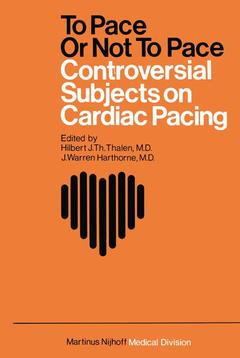To Pace or not to Pace, Softcover reprint of the original 1st ed. 1978 Controversial Subjects in Cardiac Pacing
Langue : Anglais
Coordonnateurs : Thalen Hilbert J.Th., Harthorne J.W.

The increasing number of pacemaker patients correlates with the number of pacemaker meetings that attract physicians and medical engineers entering this expanding branch of medicine. The Pacemaker Colloquium organised in Brussels April 21st and 22nd 1977 was such a meeting. It was different from previous meetings as it had no surveys or summaries on patient series but instead it focused on controversial subjects that have emerged from pacing in the past and on new developments for the future. Besides controversial papers on indications for temporary and long-term pacing, new technical developments were presented in Brussels, where for the first time the important lithium battery manufacturers demonstrated their data. The surveys on electrodes, especially the fixation mechanisms and the atrial electrodes, initiated an animated discussion. This all converged in a Round Table on the choice of the electrode-pacemaker combination. Pacemaker electrocar diography and the application of cardiac stimulation in various types oftachyar rhythmias formed two clinically oriented sessions. Mter a survey ofthe various follow-up systems a series of presentations deals for the first time with the possibilities and difficulties of the application of com puters in cardiac pacing. A Round Table on the organisation of the Pacemaker clinic closed this friendly and animated meeting. It is our sincere hope that the publication of the presented papers and dis cussions in these Proceedings will help all those active in cardiac pacing to answer some of their problems and to improve the treatment of pacemaker patients.
Opening.- Opening Address.- Official Opening.- Section I. Conduction System.- The Normal Anatomy of the Sinus Node and its Pathology.- Evaluation of the Cardiac Conduction System by His Bundle Recordings.- Significance of His Bundle Recording in Bundle Branch Block.- Satrap: A Computer Study of His Bundle Potentials Obtained by a Non-invasive Method.- A Technique for Non-Invasive His-Purkinje System (HPS) Recording.- Discussion.- Section II. To Pace or not to Pace.- Cardiac Pacing in Sick Sinus Syndrome.- Cardiac Pacing in Fascicular Block.- Cardiac Pacing in Acute Myocardial Infarction.- Prophylactic Preoperative Pacing.- Cardiac Pacing in Open Heart Surgery.- Discussion.- Section III. Energy Sources and Electronic Circuit.- Pacemaker Energy Sources, Old and New.- The Saft Lithium-Silver Chromate Battery: Performances of the Li 210 Type.- The Lithium-Iodine Cell.- The Lithium Pacemaker, a Four-Year Clinical Experience.- New Pacemaker Devices from a Technical Point of View.- New Pacemaker Circuitry from a Clinical Point of View.- End-of-Life Indications for Lithium Pacemakers.- Discussion.- Section IV. Stimulation Electrodes.- A. Atrial Electrodes.- Transmediastinal and Transthoracic Atrial Electrodes.- The Use of Coronary Sinus Pacing.- Permanent Atrial Electrodes with Special Consideration to Transvenous Endocardial Forms.- B. Ventricular Electrodes.- Results of 57 Cases with MIP 2000 Endocardial Electrode, Compared with a Series of 1200 Endocardial Electrodes.- Clinical Results with Intramural and Endocardial Electrodes Implanted for over 8 Years.- Long-term Experience with an Endocardial Screw-in Electrode.- Permanent Endocardial Pacing without Electrode Dislodgement?.- Discussion.- Section V. The Choice of the Pacemaker-Electrode Combination.- The Pacemaker-Electrode Combination and Its Relationship to Service Life.- The Choice of the Pacemaker-Electrode Combination: Clinical Implications in Paroxysmal Arrhythmias.- The Choice of the Electrode and Pacing Method for Emergency Cardiac Pacing.- Round Table.- Round Table Discussion: The Choice of the Pacemaker-Electrode Combination.- Section VI. Pacemaker Implantation: Surgeon and/or Cardiologist.- The Cooperation in Management of Pacemaker Patients.- The Teamwork in Pacemaker Implantation.- Who Should Implant a Pacemaker System, Cardiologist or Surgeon?.- The Surgeon, Who Selects and Implants?.- Discussion.- Section VII. Pacemaker Electrocardiography.- ECG Survey of Various Pacemaker Modes.- Pacemaker Electrocardiography — the Importance of QRS and T wave Configuration.- Electrocardiographic Diagnosis of Myocardial Infarction and Coronary Insufficiency in the Pacemaker Patient.- The Irregular Pacemaker: Mechanisms and Clinical Significance.- Complex Demand Pacemaker Arrhythmias: The Differential Diagnosis of Pacemaker Pauses.- Electrocardiographic Patterns in Sick Sinus Syndrome.- Discussion.- Section VIII. Tarchycardia and Pacing.- Diagnostic Pacing in Tachycardia.- Pacing in Supraventricular Tachycardia.- Risks of Delayed Potentials in Pacemaker Patients Prone to Ventricular Tachycardia.- A Special Approach in the Management of Re-entry Tachycardias.- Discussion.- Section IX. Pacemaker Follow-up Methods.- Pacemaker Follow-up Methods.- Significance of Photoanalysis in a Pacemaker Surveillance System.- Pacemaker Failure Detectable by Rontgen Analysis.- Transtelephone Pacemaker Monitoring.- Pacemaker Follow-up by a Self-Check system.- Discussion.- Section X. Computer Application in Pacemaker Registration and Follow-up.- Computer Applications for the Control of Pacemaker Patients:Remarks and Personal Experience.- Computer Storage of Pacemaker Data.- Storage, Evaluation and Application of Data in a Pacemaker Clinic.- Digital Computers in Pacemaker Analysis.- The National Pacemaker Databank.- Impulse Analyser-Computer Interface: A New Way to Store Pacemaker Data.- The Significance in Quality Control of a Computer for Production- and Field-Data. Complete Traceability, possible or not?.- Discussion.- Round Table Discussion.- The Pacemaker Clinic: Organization and Patient Load.- Official Closure.- Importance of Colloquium for the Clinician.- Importance of Colloquium for Research and Development.- Closure.- Farewell.
Date de parution : 02-2012
Ouvrage de 480 p.
15.5x23.5 cm
Thème de To Pace or not to Pace :
Mots-clés :
anatomy; differential diagnosis; electrocardiogram (ECG); electrocardiography; heart; surgery
© 2024 LAVOISIER S.A.S.



